金融科技和金融采购4.0外文文献翻译2018-2019
金融体系中英文对照外文翻译文献

金融体系中英文对照外文翻译文献(文档含英文原文和中文翻译)Comparative Financial Systems1 What is a Financial System?The purpose of a financial system is to channel funds from agents with surpluses to agents with deficits. In the traditional literature there have be en two approaches to analyzing this process. The first is to consider how agents interact through financial markets. The second looks at the operation offinancial intermediaries such as banks and insurance companies. Fifty years ago, the financial system co uld be neatly bifurcated in this way. Rich house-holds and large firms used the equity and bond markets,while less wealthy house-holds and medium and small firms used banks, insurance companies and other financial institutions. Table 1, for example, shows the ownership of corporate equities in 1950. Households owned over 90 percent. By 2000 it can be seen that the situation had changed dramatically.By then households held less than 40 percent, nonbank intermediaries, primarily pension funds and mutual funds, held over 40 percent. This change illustrates why it is no longer possible to consider the role of financial markets and financial institutions separately. Rather than intermediating directly between households and firms, financial institutions have increasingly come to intermediate between households and markets, on the one hand, and between firms and markets,on the other. This makes it necessary to consider the financial system as anirreducible whole.The notion that a financial system transfers resources between households and firms is, of course, a simplification. Governments usually play a significant role in the financial system. They are major borrowers, particularlyduring times of war, recession, or when large infrastructure projects are being undertaken. They sometimes also save significant amounts of funds. For example, when countries such as Norway and many Middle Eastern States have access to large amounts of natural resources (oil), the government may acquire large trust funds on behalf of the population.In addition to their roles as borrowers or savers, governments usually playa number of other important roles. Central banks typically issue fiat money and are extensively involved in the payments system. Financial systems with unregulated markets and intermediaries, such as the US in the late nineteenth century, often experience financial crises.The desire to eliminate these crises led many governments to intervene in a significant way in the financial system. Central banks or some other regulatory authority are charged with regulating the banking system and other intermediaries, such as insurance companies. So in most countries governments play an important role in the operation of financialsystems. This intervention means that the political system, which determines the government and its policies, is also relevant for the financial system.There are some historical instances where financial markets and institutions have operated in the absence of a well-defined legal system, relyinginstead on reputation and other im plicit mechanisms. However, in most financial systems the law plays an important role. It determines what kinds ofcontracts are feasible, what kinds of governance mechanisms can be used for corporations, the restrictions that can be placed on securities and so forth. Hence, the legal system is an important component of a financial system.A financial system is much more than all of this, however. An important pre-requisite of the ability to write contracts and enforce rights of various kinds is a system of accounting. In addition to allowing contracts to be written, an accounting system allows investors to value a company more easily and to assess how much it would be prudent to lend to it. Accounting information is only one type of information (albeit the most important) required by financial systems. The incentives to generate and disseminate information are crucial features of a financial system.Without significant amounts of human capital it will not be possible for any of these components of a financial system to operate effectively. Well-trained lawyers, accountants and financial professionals such as bankers are crucial for an effective financial system, as the experience of Eastern Europe demonstrates.The literature on comparative financial systems is at an early stage. Our survey builds on previous overviews by Allen (1993), Allen and Gale (1995) and Thakor (1996). These overviews have focused on two sets of issues.(1)Normative: How effective are different types of financial system atvarious functions?(2) Positive: What drives the evolution of the financial system?The first set of issues is considered in Sections 2-6, which focus on issues of investment and saving, growth, risk sharing, information provision and corporate governance, respectively. Section 7 consider s the influence of law and politics on the financial system while Section 8 looks at the role financial crises have had in shaping the financial system. Section 9 contains concludingremarks.2 Investment and SavingOne of the primary purposes of the financial system is to allow savings to be invested in firms. In a series of important papers, Mayer (1988, 1990) documents how firms obtained funds and financed investment in a number of different countries. Table 2 shows the results from the most recent set of studies, based on data from 1970-1989, using Mayer’s methodology. The figures use data obtained from sources-and-uses-of-funds statements. For France, the data are from Bertero (1994), while for the US, UK, Japan and Germany they are from Corbett and Jenkinson (1996). It can be seen that internal finance is by far the most important source of funds in all countries.Bank finance is moderately important in most countries and particularly important in Japan and France. Bond finance is only important in the US and equity finance is either unimportant or negative (i.e., shares are being repurchased in aggregate) in all countries. Mayer’s studies and those using his methodology have had an important impact because they have raised the question of how important financial marke ts are in terms of providing funds for investment. It seems that, at least in the aggregate, equity markets are unimportant while bond markets are important only in the US. These findings contrast strongly with theemphasis on equity and bond markets in the traditional finance literature. Bank finance is important in all countries,but not as important as internal finance.Another perspective on how the financial system operates is obtained by looking at savings and the holding of financial assets. Table 3 shows t he relative importance of banks and markets in the US, UK, Japan, France and Germany. It can be seen that the US is at one extreme and Germany at the other. In the US, banks are relatively unimportant: the ratio of assets to GDP is only 53%, about a third the German ratio of 152%. On the other hand, the US ratio of equity market capitalization to GDP is 82%, three times the German ratio of 24%. Japan and the UK are interesting intermediate cases where banks and markets are both important. In France, banks are important and markets less so. The US and UK are often referred to as market-based systems while Germany, Japan and France are often referred to as bank-based systems. Table 4 shows the total portfolio allocation of assets ultimately owned by the household sector. In the US and UK, equity is a much more important component of household assets than in Japan,Germany and France. For cash and cash equivalents (which includes bank accounts), the reverse is true. Tables 3 and 4 provide an interesting contrast to Table 2. One would expect that, in the long run, household portfolios would reflect the financing patterns of firms. Since internal finance accrues to equity holders, one might expect that equity would be much more important in Japan, France and Germany. There are, of course, differences in the data sets underlying the different tables. For example, household portfolios consist of financial assets and exclude privately held firms, whereas the sources-and-uses-of-funds data include all firms. Nevertheless, it seem s unlikely that these differences could cause such huge discrepancies. It is puzzling that these different ways of viewing the financial system produce such radically different results.Another puzzle concerning internal versus external finance is the difference between the developed world and emerging countries. Although it is true for the US, UK, Japan, France, Germany and for most other developed countries that internal finance dominates external finance, this is not the case for emerging countries. Singh and Hamid (1992) and Singh (1995) show that, for a range of emerging economies, external finance is more important than internal finance. Moreover, equity is the most important financing instrument and dominates debt. This difference between the industrialized nations and the emerging countries has so far received little attention. There is a large theoretical literature on the operation of and rationale for internal capital markets. Internal capital markets differ from external capital markets because of asymmetric information, investment incentives, asset specificity, control rights, transaction costs or incomplete markets There has also been considerable debate on the relationship between liquidity and investment (see, for example, Fazzari, Hubbard and Petersen(1988), Hoshi, Kashyap and Scharfstein (1991))that the lender will not carry out the threat in practice, the incentive effect disappears. Although the lender’s behavior is now ex post optimal, both parties may be worse off ex ante.The time inconsistency of commitments that are optimal ex ante and suboptimal ex post is typical in contracting problems. The contract commits one to certain courses of action in order to influence the behavior of the other party. Then once that party’s behavior has been determined, the benefit of the commitment disappears and there is now an incentive to depart from it.Whatever agreements have been entered into are subject to revision because both parties can typically be made better offby “renegotiating” the original agreement. The possibility of renegotiation puts additional restrictions on the kind of contract or agreement that is feasible (we are referring here to the contract or agreement as executed, ratherthan the contract as originally written or conceived) and, to that extent, tends to reduce the welfare of both parties ex ante. Anything that gives the parties a greater power to commit themselves to the terms of the contract will, conversely, be welfare-enhancing.Dewatripont and Maskin (1995) (included as a chapter in this section) have suggested that financial markets have an advantage over financial intermediaries in maintaining commitments to refuse further funding. If the firm obtains its funding from the bond market, th en, in the event that it needs additional investment, it will have to go back to the bond market. Because the bonds are widely held, however, the firm will find it difficult to renegotiate with the bond holders. Apart from the transaction costs involved in negotiating with a large number of bond holders, there is a free-rider problem. Each bond holder would like to maintain his original claim over the returns to the project, while allowing the others to renegotiate their claims in order to finance the additional investment. The free-rider problem, which is often thought of as the curse of cooperative enterprises, turns out to be a virtue in disguise when it comes to maintaining commitments.From a theoretical point of view, there are many ways of maintaining a commitment. Financial institutions may develop a valuable reputation for maintaining commitments. In any one case, it is worth incurring the small cost of a sub-optimal action in order to maintain the value of the reputation. Incomplete information about the borrower’s type may lead to a similar outcome. If default causes the institution to change its beliefs about the defaulter’s type, then it may be optimal to refuse to deal with a firm after it has defaulted. Institutional strategies such as delegating decisions to agents who are given no discretion to renegotiate may also be an effective commitment device.Several authors have argued that, under certain circumstances, renegotiation is welfare-improving. In that case, the Dewatripont-Maskin argument is turned on its head. Intermediaries that establish long-term relationships with clients may have an advantage over financial markets precisely because it is easier for them to renegotiate contracts.The crucial assumption is that contracts are incomplete. Because of the high transaction costs of writing complete contracts, some potentially Pareto-improving contingencies are left out of contracts and securities. This incompleteness of contracts may make renegotiation desirable. The missing contingencies can be replaced by contract adjustments that are negotiated by the parties ex post, after they observe the realization of variables on which the contingencies would have been based. The incomplete contract determines the status quo for the ex post bargaining game (i.e., renegotiation)that determines the final outcome.An import ant question in this whole area is “How important are these relationships empirically?” Here there does not seem to be a lot of evidence.As far as the importance of renegotiation in the sense of Dewatripont and Maskin (1995), the work of Asquith, Gertner and Scharfstein (1994) suggests that little renegotiation occurs in the case of financially distressed firms.Conventional wisdom holds that banks are so well secured that they can and do “pull the plug” as soon as a borrower becomes distressed, leaving theunsecured creditors and other claimants holding the bag.Petersen and Rajan (1994) suggest that firms that have a longer relationship with a bank do have greater access to credit, controlling for a number of features of the borrowers’ history. It is not clea r from their work exactly what lies behind the value of the relationship. For example, the increased access to credit could be an incentive device or it could be the result ofgreater information or the relationship itself could make the borrower more credit worthy. Berger and Udell (1992) find that banks smooth loan rates in response to interest rate shocks. Petersen and Rajan (1995) and Berlin and Mester (1997) find that smoothing occurs as a firm’s credit risk changes.Berlin and Mester (1998) find that loan rate smoothing is associated with lower bank profits. They argue that this suggests the smoothing does not arise as part of an optimal relationship.This section has pointed to a number of issues for future research.• What is the relationship between th e sources of funds for investment,as revealed by Mayer (1988, 1990), and the portfolio choices of investorsand institutions? The answer to this question may shed some light onthe relative importance of external and internal finance.• Why are financing patterns so different in developing and developedeconomies?• What is the empirical importance of long-term relationships? Is renegotiationimportant is it a good thing or a bad thing?• Do long-term relationships constitute an important advantage of bankbasedsystems over market-based systems?金融体系的比较1、什么是金融体系?一个金融系统的目的(作用)是将资金从盈余者(机构)向短缺者(机构)转移(输送)。
金融毕业论文外文文献翻译
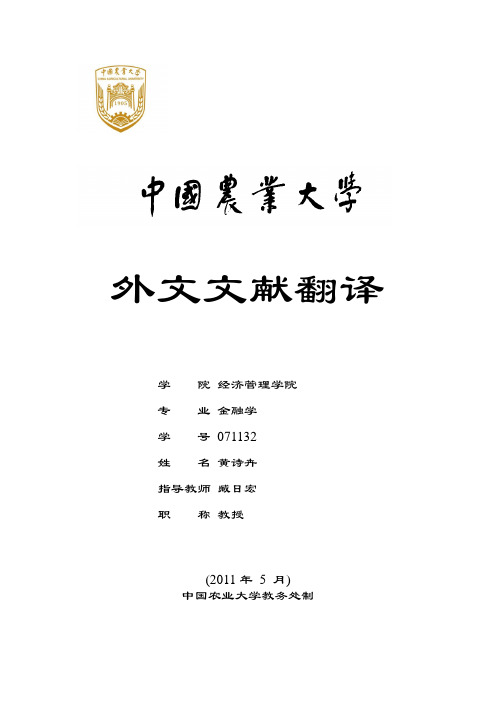
外文文献翻译学院经济管理学院专业金融学学号071132姓名黄诗卉指导教师臧日宏职称教授(2011年5 月)中国农业大学教务处制文献题目:非银行机构的银行业务文献出处:www。
emeraldinsight。
com译文内容:摘要目的-—金融危机以及随后而来对现存银行机构的不信任,为新的竞争者进入金融服务提供了机会。
银行业以外的机构通过他们受信赖的品牌,更强的资料获取技术以及更强大的客户服务理念无形中动摇了金融服务的潜规则,也因此将生意带离了传统的操作者。
此论文目的就是检验这种无形的非银行机构在英国金融服务行业的进入以及扩张,并分析他们的前景,在最后仔细考虑他们将面对的巨大挑战.设计方法:此论文以一篇于2010年发表的《乐购银行和维珍理财》报告为基准:探讨银行业没有银行.此报告提供了对英国市场的分析以及潜在的主要竞争者。
这个报告更为精简的在论文中展现,并且经过修改更好的体现了国际关联。
调查结果:论文讨论了乐购银行和维珍理财的优缺点,并总结了他们在进入这个行业所要面对的各种挑战。
创新之处:论文十分中肯的给出了公众对乐购银行和维珍理财进入英国金融服务行业的意见。
它还提供了其他国家该行业新竞争者的教训。
关键词:金融服务,银行,消费行为论文形式:观点论文简介金融危机对未来的银行业构成产生多重大的影响?毫无质疑的,此次的危机使银行的资产,流动性,会计方式都重大的改变.但是,危机还前所未有的使此领域向新的竞争者的进入打开大门?民众对主流银行深深地不信任使其他领域野心勃勃的公司获得了成为金融服务行业的主要提供商巨大契机?非银行业者进入金融服务先前已经被无数次讨论。
1994年一篇关于美国银行家的圆桌研究总结了“银行业的本质是一个现代的经济;然后银行却不是"。
评论员也预测了银行业以外的机构将用他们更强的信息获取技术和客户服务来动摇金融服务行业,谨慎的吃下将有利可图的生意并孤立银行。
在众多市场中,零售业者将作为最重要的竞争者。
金融学英文文献翻译
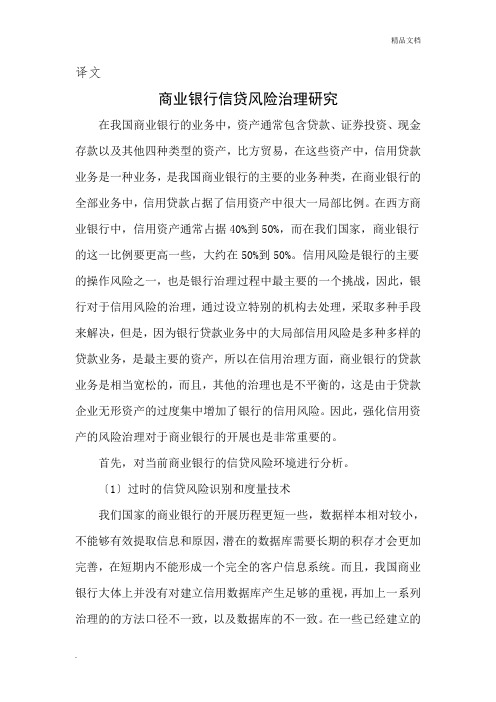
译文商业银行信贷风险治理研究在我国商业银行的业务中,资产通常包含贷款、证券投资、现金存款以及其他四种类型的资产,比方贸易,在这些资产中,信用贷款业务是一种业务,是我国商业银行的主要的业务种类,在商业银行的全部业务中,信用贷款占据了信用资产中很大一局部比例。
在西方商业银行中,信用资产通常占据40%到50%,而在我们国家,商业银行的这一比例要更高一些,大约在50%到50%。
信用风险是银行的主要的操作风险之一,也是银行治理过程中最主要的一个挑战,因此,银行对于信用风险的治理,通过设立特别的机构去处理,采取多种手段来解决,但是,因为银行贷款业务中的大局部信用风险是多种多样的贷款业务,是最主要的资产,所以在信用治理方面,商业银行的贷款业务是相当宽松的,而且,其他的治理也是不平衡的,这是由于贷款企业无形资产的过度集中增加了银行的信用风险。
因此,强化信用资产的风险治理对于商业银行的开展也是非常重要的。
首先,对当前商业银行的信贷风险环境进行分析。
〔1〕过时的信贷风险识别和度量技术我们国家的商业银行的开展历程更短一些,数据样本相对较小,不能够有效提取信息和原因,潜在的数据库需要长期的积存才会更加完善,在短期内不能形成一个完全的客户信息系统。
而且,我国商业银行大体上并没有对建立信用数据库产生足够的重视,再加上一系列治理的的方法口径不一致,以及数据库的不一致。
在一些已经建立的信用数据库中,一些数据的真实性和完整性值得疑心,这些问题直接影响商业银行的信贷风险的客观和公正的评价。
与此同时,我国商业银行的信贷风险治理的方法和技术仍不完善,国外已经采纳许多先进的信贷风险治理工具,尤其是信贷风险评估和信贷风险防范技术等等。
〔2〕信贷风险处理手段较少信贷风险治理是指将信贷风险降低到最小的一个过程,信贷风险是客观存在的,这意味着银行是肯定会承当肯定的信用风险的。
在我国,信贷风险操纵和处理机制是相当弱的,方法手段很单一,仅仅抵押贷款有着第三方的保证,而且信贷资产的证券化和其他信贷风险的操纵方法并没有被有效的使用,信贷资产的全面治理没有真正的落实。
互联网金融外文翻译
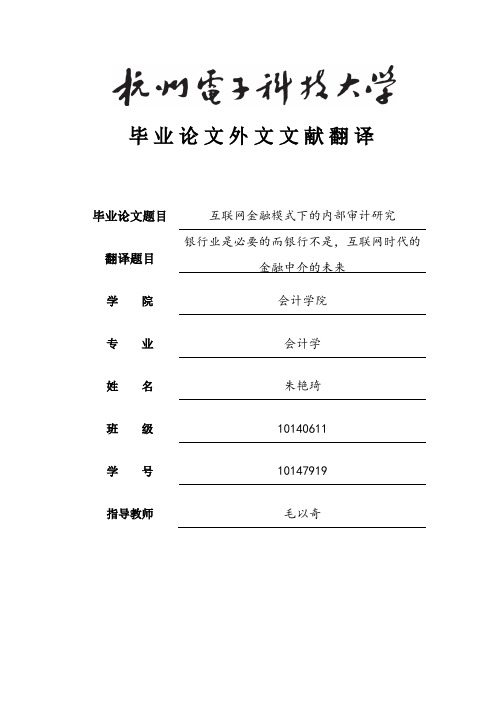
毕业论文外文文献翻译毕业论文题目互联网金融模式下的内部审计研究翻译题目银行业是必要的而银行不是,互联网时代的金融中介的未来学院会计学院专业会计学姓名朱艳琦班级10140611 学号10147919 指导教师毛以奇译文银行业是必要的而银行不是,互联网时代的金融中介机构的未来摘要本文探讨了互联网时代下金融机构和银行作为特殊的金融机构的未来可能是怎样的问题。
由于互联网而导致的交易费用的减少会降低进入金融产品市场的壁垒,因为有可能不再需要运行成本密集型的分支的大型系统。
但是,对金融机构的职能研究表明,不是每个人都可以销售和经销金融产品。
这是真的,因为金融业务中的信息不对称问题需要一个拥有良好信誉的中介,也因为需要限制大型资本基金转换资产的风险。
这两个要求变现了进入金融中介市场的重要壁垒。
并不是每一个金融产品会因为互联网的崛起而将面临更多的竞争,只有那些标准化和低风险的产品。
此外,那些拥有可观资本和良好声誉的大公司可能被视为银行的新竞争者。
关键字:银行业,银行,金融机构,互联网1、引言“银行业是19世纪的钢铁行业。
”当谈到关于新的信息技术对银行的影响的谈论时,这句话经常被提起。
更一般来说,可能有人会问,新信息技术是如何成功的,特别是互联网的,可能会改变商业和金融机构的市场情况。
在互联网的帮助下,人们可以执行所有银行的业务,而不需要银行。
这意味着传统银行分支机构的中介。
此外,互联网已经使客户直接从网上购买股票而不需要访问当地的分支银行。
从更广泛的意义上来说,在互联网的帮助下,金融市场的供给和需求可能通过互联网满足,而不需要金融中介机构。
互联网的崛起是否真的是金融中介机构的威胁?在急剧减少的交易成本情况下,商业和竞争将如何变化?本文考察了互联网的成功对金融机构和银行的影响。
2、金融机构的发展几个世纪以来,许多金融交易需要个人的存在。
随着现代信息技术的发展,这些都被改变了。
如今,客户可以在不进入当地分支银行的情况下进行任何金融交易。
互联网金融中英文对照外文翻译文献

中英文对照外文翻译文献(文档含英文原文和中文翻译)互联网金融对传统金融的影响摘要网络的发展,深刻地改变甚至颠覆了许多传统行业,金融业也不例外。
近年来,金融业成为继商业分销、传媒之后受互联网影响最为深远的领域,许多基于互联网的金融服务模式应运而生,并对传统金融业产生了深刻的影响和巨大的冲击。
“互联网金融”成为社会各界关注的焦点。
互联网金融低成本、高效率、关注用户体验,这些特点使其能够充分满足传统金融“长尾市场”的特殊需求,灵活提供更为便捷、高效的金融服务和多样化的金融产品,大大拓展了金融服务的广度和深度,缩短了人们在时空上的距离,建立了一种全新的金融生态环境;可以有效整合、利用零散的时间、信息、资金等碎片资源,积少成多,形成规模效益,成为各类金融服务机构新的利润增长点。
此外,随着互联网金融的不断渗透和融合,将给传统金融行业带来新的挑战和机遇。
互联网金融可以促进传统银行业的转型,弥补传统银行在资金处理效率、信息整合等方面的不足;为证券、保险、基金、理财产品的销售与推广提供新渠道。
对于很多中小企业来说,互联网金融拓展了它们的融资渠道,大大降低了融资门槛,提高了资金的使用效率。
但是,互联网金融的跨行业性决定了它的风险因素更为复杂、敏感、多变,因此要处理好创新发展与市场监管、行业自律的关系。
关键词:互联网金融;商业银行;影响;监管1 引言互联网技术的不断发展,云计算、大数据、社交网络等越来越多的互联网应用为传统行业的业务发展提供了有力支持,互联网对传统行业的渗透程度不断加深。
20世纪末,微软总裁比尔盖茨就曾断言,“传统商业银行会成为新世纪的恐龙”。
如今,随着互联网电子信息技术的发展,我们真切地感受到了这种趋势,移动支付、电子银行早已在我们的日常生活中占据了重要地位。
由于互联网金融的概念几乎完全来自于商业实践,因此目前的研究多集中在探讨互联网金融的具体模式上,而对传统金融行业的影响力分析和应对措施则缺乏系统性研究。
金融经济外文文献翻译

郑州大学商学院金融外文文献翻译题目:WTO and Capital Peking’s Economy指导教师:职称:学生姓名:学号:专业:院(系):完成时间:WTO and Capital Peking’s EconomyJ effrey J . McMillan ABSTRACTChina’s accession to the WTO is an important event of our economic life in the course of reforms and opening. Therefore, Peking Municipal Government has established a special research team, which is designated to the study on the subject of Ch ina’s accession to the WTO and its impacts on the economic development of the capital. Here are only some views on the primary results of the research.I. Impacts on the economy of the capitalChina’s accession to the WTO means that our country will integrate and participate in the course of the economic globalization with an unprecedented extent and depth, and Peking will be in a brand new environment of development. The requirements of the market system reflected by the free trade principles and rules advocated by the WTO and the industrial orientation implied in the furtherance of the new international division of labor are consistent with the general direction of the economic development of the capital. In front of the wider opening of the market system, Peking, a city as the center for international communication, is endowed with resources of advanced technology and education, stronger comprehensive economic power and a fully established foreign-oriented pattern of multiple levels involved in wide fields, and thus Peking is in a more favorable competitive position as compared with other areas possibly with some relative advantages in international competition. Therefore, with correctly determined development strategy and tactics and initiatives in making full use of advantages and avoiding disadvantages, Peking may maximally share the benefits and opportunities brought forth by China’s accession to the WTO and reduce the shocks and pulse, hence facilitating the promotion of the economic development of the capital.II. Basic principles to be observed in developing the economy of the capital upon China’s accession to the WTOUpon China’s accession to the WTO, the economic development of the capital shall abide by the principles of comparative advantages and stick to the principles of reforms and innovation and the principles of the balance of focus on both domestic and foreign opening, thus pushing the economic growth and increasingly expanding the three demands for investment, consumption and import and export.In view of investment, it is initially estimated that for the first years upon China’s accession to the WTO, the domestic investment growth will be impacted by about 1--2%, the growth of the utilization of foreign investment will be impacted by 8--10%, and calculated on the basis of the current investment composition, total investment of fixed assets will witness a growth of 2--3.5%. Based on the elasticity of fixed asset against GDP from 1982 through 1998, the growth of GDP will be promoted by 1.5--2.5%. In view of consumption, during the initial period, China’s accession to the WTO will promote the growth rate of total residential consumption by 1--1.5%, and the growth rate of the ultimate total annual consumption will be promoted by about 0.6%, which means that upon complete realization of the agreement commitments, China’s accession to the WTO will promote the growth of total residential consumption by 5--6% in Peking, with the growth of the ultimate total annual consumption promoted by about 4%, thus bringing forth the growth of GDP by 2--2.5%. In view of import and export, the export of the traditional advantageous products of Peking Municipality will witness more growth, especially that of light textile products and mechanic-electrical products. Upon China’s accession to the WTO, the demands for import of the whole municipality witnesses obvious increase at the growth rate over that of export, and the situation of more import than export may not change. In view of employment, general trend is that the sustained economic growth will bring forth the increase of total employment, and the situation of more supply of labor than demand may be alleviated. Especially, the totalintroduction of foreign investment by Peking will witness more growth, and the development of tertiary industry will be accelerated, which may create new jobs though the pressure of employment is still big in a short term. With the accession to the WTO,the economic development of the capital is sure to face a issue of optimization and upgrading of industrial composition. According to our analysis, the industries with more development opportunities of the capital mainly include agriculture, hi-tech, foods industry, light industry, tourism, scientific, educational, cultural and health causes, information consulting industry, and exhibition industry. The industries with more challenges of the capital include electronic and communication equipment manufacturing industry, petrochemical industry, auto industry, machinery industry, metallurgical industry, building material industry, financial and insurance industry, commercial and beverage industry, transportation and post industry. Accordingly, we will carry out adjustment of industrial composition based on the above-mentioned analysis.III. Impacts on foreign economy and trade of the capitalAt present, there exists obvious gaps between the foreign trade management system of our country and the requirements of the WTO, which are embodied as follows:(1)Incomplete system of laws and regulations;(2)High import tariffs;(3)Numerous onus administrative measures of import and export: currently, 35 varieties of import commodities and 59 varieties of export commodities adopt licensing administration, most of which are not permitted for imposition of import and export restrictions by the WTO;(4)Failure to fully implement non-discriminatory principles, such as not adopting national treatment with foreign investment enterprises;(5)Insufficient transparency in foreign economic and trade policies. (6)The resources control and environment pressurePeking belongs to serious water shortage region, person all the water resources shortage 300 sign a square rice, only occupy quantity for the national personof 1/8, person in world all occupies quantity of 1/30, the water resources supply and demand antinomy's turning worse continuously will be the suburban area economy to develop main check and supervision factor;Resources quantity in land is limited, spare resources shortage, the agriculture uses ground to reduce gradually;The village labor force character is hard to satisfy the objective demand that the economy develops quickly.In the meantime, the suburban area is the ecosystem natural cover of the capital city, the ecosystem environment foundation still weaker, constuct and protect ecosystem environment and carry out and can keep on a development to face huge mission of in the economy the development the process.Face new situation, the suburban area economy the development still exists some antinomies and problem, main performance at:The economic total amount and structure and capital city position,economy movement mechanism and market economy request,the industrialization level and modernization strategy,small town the development and construction internationalize the metropolis,the farmer income growth speed and contract the city country difference, etc. still exists not adapt of place.How develop the niche,science and technology,information of the suburban area well etc. advantage, resolve these antinomies and problem further, BE"15" periodses speed the suburban area economy development step,the exaltation agriculture and village modernize level face of important topic.The influence that joins WTO to the capital city outside traid mainly expresses for the traditional advantage product export growth, the exit of the traditional market steady growth, the newly arisen market export will have already greatlied compare to increase as well, each kind of product that export a business enterprise is subjected to the influence degree dissimilarity, the overseas-funded enterprises advantage is obvious, outside traid the professional company difficulty compare greatly, import may significant growth, serve the trade income and expend all will with sooner the speed increase. Will exceed the goods trade to attain this year according to statistics 40 haveanother hundred million.Drawing on the foreign capital influence to the capital city to mainly express for the policy will make further adjustment;To the special policy of the overseas-funded enterprises to citizen the treatment change;Loosen outward a company the industry realm of the investment;Increase the clarity that the outside company invests law,laws.The impacts of the accession of the WTO on the foreign trade of the capital are mainly reflected as follows: the export of traditional advantageous industries will witness growth, the export of traditional market will witness stable growth, the export of the emerging market will also witness rapid growth, the impacts are different on the products of various export-oriented enterprises whereby the advantages of foreign-invested enterprises are obvious and while the difficulties of professional foreign trade companies may be big. Import may witness a big growth with the incomes and expenditures of trade in services growing even quicker. According to statistics, trade in services will exceed trade in goods by more than RMB4b.The impacts on the introduction of foreign investment of the capital are mainly as follows: policies will be further adjusted; the preferential policies with foreign-invested enterprises will shift to national treatment; the industrial fields will be extended for foreign investment; and the transparency will be enhanced in the laws and regulations on foreign investmentIV. Policy proposals on the foreign economic and trade development of the capital and speeding up the reforms of state-owned foreign trade enterprises.For the institutional reforms of foreign economic and trade systems, the administrative functions of the government will be changed in foreign economy and trade, and the municipal government will adopt measures for streamlining the establishment and institutions, simplifying the procedures of the approval and ratification functions, enhancing efficiency and improving the environment quality; speeding up the construction in foreign-related economic laws and regulations and policies; and making better use of the roles of foreign economic and trade intermediaries and institutions.For trade in goods, mainly making use of the advantages of the capital for creating a good trade environment; implementing the strategy of trade promotion based on science and technology, optimizing the composition of export commodities, increasing the export of hi-tech produces by even greater extent, and especially focusing on developing the software export in Peking; implementing the strategy of “going out” for development of transnational operations; and expending the subjects for operations of foreign trade, thus forming large-scale foreign economic and trade groups.In terms of trade in services, mainly establishing and perfecting the management system of the trade in services and formulating plans; perfecting the policy provisions on service industries and the policies on trade in services; and speeding up the cultivation of the talents in trade of services.In terms of utilization of foreign investment, mainly reinforcing the strength in improving investment climate; adjusting the strategy for introduction of foreign merchants and capital; and expanding the fields, channels and means.The measures for reforms of foreign trade enterprises include expansion of opening, adopting the important way of introduction of foreign investment and the process of industries, with the sales channels of foreign investment, thus reducing the threshold of policies; carrying out enterprise restructuring for advancement by streamlining; allowing for employees’ holding of shares, option incentives, and formulating relaxed systems for maximal maneuvering and scheduling of the initiatives of people; allowing for the adoption of conversion of debts into shares; and allowing for the bankruptcy of foreign trade companies.W T O 与首都北京经济[摘要]中国入世,是中国经济生活和改革开放进程中的重大事件。
互联网金融外文文献翻译
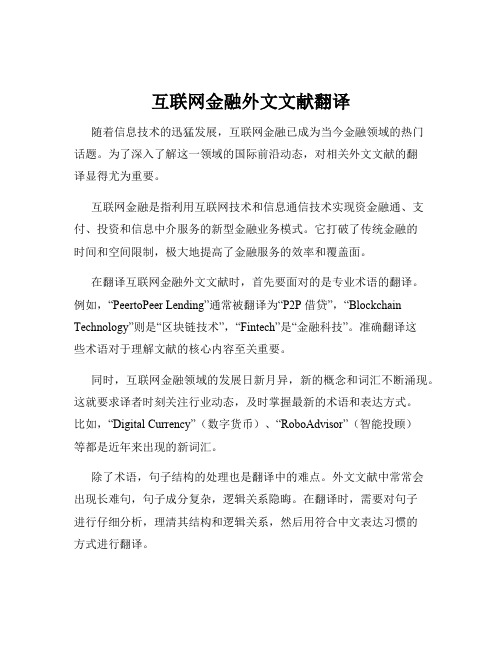
互联网金融外文文献翻译随着信息技术的迅猛发展,互联网金融已成为当今金融领域的热门话题。
为了深入了解这一领域的国际前沿动态,对相关外文文献的翻译显得尤为重要。
互联网金融是指利用互联网技术和信息通信技术实现资金融通、支付、投资和信息中介服务的新型金融业务模式。
它打破了传统金融的时间和空间限制,极大地提高了金融服务的效率和覆盖面。
在翻译互联网金融外文文献时,首先要面对的是专业术语的翻译。
例如,“PeertoPeer Lending”通常被翻译为“P2P 借贷”,“Blockchain Technology”则是“区块链技术”,“Fintech”是“金融科技”。
准确翻译这些术语对于理解文献的核心内容至关重要。
同时,互联网金融领域的发展日新月异,新的概念和词汇不断涌现。
这就要求译者时刻关注行业动态,及时掌握最新的术语和表达方式。
比如,“Digital Currency”(数字货币)、“RoboAdvisor”(智能投顾)等都是近年来出现的新词汇。
除了术语,句子结构的处理也是翻译中的难点。
外文文献中常常会出现长难句,句子成分复杂,逻辑关系隐晦。
在翻译时,需要对句子进行仔细分析,理清其结构和逻辑关系,然后用符合中文表达习惯的方式进行翻译。
例如:“The rapid development of fintech has not only disrupted the traditional financial landscape but also created numerous opportunities for innovative financial services, which has posed both challenges and prospects for the regula tory framework” 可以翻译为:“金融科技的快速发展不仅颠覆了传统的金融格局,还为创新金融服务创造了众多机会,这给监管框架带来了挑战和前景。
2019年第四季度金融科技报告(英文)-GP. Bullhound-2020.02-31页
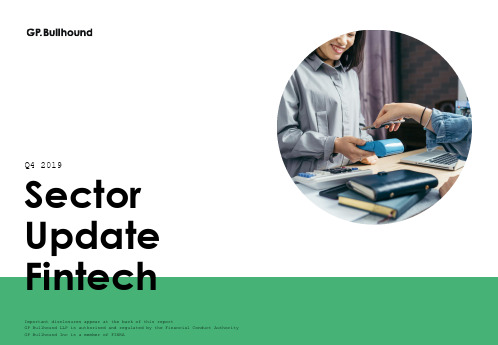
Section 1
Key sector takeaways
4
GP Bullhound’s views on current trends in fintech
1
Latin America makes its mark on the fintech stage
2
Tech-enabled funding: The rise of revenue-based financing
Q4 2019
Sector Update Fintech
Important disclosures appear at the back of this report GP Bullhound LLP is authorised and regulated by the Financial Conduct Authority GP Bullhound Inc is a member of FINRA
3
Fintech specialist investors increase dry powder
5
Current trends in fintech
1
Latin America makes its mark on the fintech stage
▪ Investors are increasingly backing financial services companies in Latin America as they look to capitalise on the attractive demographics, strong macro-economic growth and growing demand for more innovative financial products
- 1、下载文档前请自行甄别文档内容的完整性,平台不提供额外的编辑、内容补充、找答案等附加服务。
- 2、"仅部分预览"的文档,不可在线预览部分如存在完整性等问题,可反馈申请退款(可完整预览的文档不适用该条件!)。
- 3、如文档侵犯您的权益,请联系客服反馈,我们会尽快为您处理(人工客服工作时间:9:00-18:30)。
金融科技和金融采购4.0外文翻译2018-2019英文Fintech and Procurement Finance 4.0Bernardo NicolettiAbstractThe future of procurement finance is connected to the digital transformation, which in the case of procurement finance is a digital revolution connected with Business 4.0. The correct concept is to consider procurement finance 4.0 as a platform, with several actors—proprietors, providers, producers, and purchasers—with interchangeable roles. Fintech organizations are and will play more and more an important role in this new vision. At the same time, the technological solution which can make all this possible is blockchain, whose characteristics are more and more appreciated around the world. The digital transformation can gain a lot also from artificial intelligence and mobility.Keywords: Industry 4.0,Procurement 4.0,Procurement finance,Platform,Open banking,Blockchain,Smart contracts,Artificial intelligence,B2B cloud ,FintechIntroductionThis chapter analyzes the future of procurement finance, in terms of potential organizational and technological developments, and defines itprocurement finance 4.0.There are essentially two ways to consider procurement finance 4.0. They are strictly connected with the role that procurement should play in an organization. The role could be either of support or primary, according to the definitions introduced by Porter in its value chain model.1If procurement has a support role, it is a function which supports the other primary and secondary functions. On the contrary, if procurement has a primary role, it would be seen as a primary contributor to adding value to the organization.The two potential roles would be rather different in a procurement 4.0 vision.In the support role, procurement 4.0 would be essentially a support to an Industry 4.0 initiative. This is an initiative which stresses at the maximum connectivity and automation of all the resources in the organization, be them machines, infrastructure, products, operators, and so on. This is the vision of procurement finance 4.0 included in many pieces of the literature.The author of this book believes that procurement is essentially a primary function in Porter’s value chain model. Procurement could contribute between 50 and 80 percent of the operating costs. This value-added contribution is among the largest in the functions of an organization. Under this vision, procurement 4.0, and hence procurementfinance 4.0, is substantially different from the one with procurement in a support role. Industry 4.0 is essentially based on interconnection and on automation. Similarly, procurement finance 4.0 should be based on the same principle as a primary function in adding value to the organization rather than only to support an Industry 4.0 initiative.Procurement 4.0 considers procurement as a platform. A platform is an organization based on enabling value-creating interactions between producers and consumers. A platform is an evolving organization or meta-organization that:federates and coordinates constitutive agents who can innovate and compete;creates value by generating and harnessing economies of scope in procurement and/or in demand;involves a modular solution composed of a core and a periphery.This vision of procurement 4.0 sees the interconnection based on the model Industry 4.0 and the automation based on a technology which supports interconnection. This technology is blockchain.7 The interconnection among the modules of the platform should be based on cloud computing which allows a cheap, flexible, and effective way to link all the components.This chapter develops this concept and this model of procurement finance 4.0. Firstly, the development of the organizations is consideredfrom the different aspects which are strongly impacting on them all over the world.The following section analyzes the technological developments, on the basis of the organizational developments but also strongly influenced by them.The combination of these two developments is the base for the future vision of the organizations and of the procurement finance processes.Procurement Finance 4.0One of the key paradigms of Industry 4.0 is the use of modern information and communication technology (ICT) integrated with automation. ICT has supported procurement processes since a long time. The concep t of electronic procurement (or “e-procurement”) is well established. The architecture of e-procurement has been defined. Industry 4.0 pushes further the concept of digitization based on the characteristics of the initiative. The integration in this model requires a comprehensive approach combined with process re-engineering.Industry 4.0 has been compared with previous disruptive innovations: the so-called industrial revolutions. They have in common an initiation not based on a single technology but on the interaction of a number of technologies whose effect created new solutions.The widespread use of the telecommunication networks (andespecially of the Internet) marked the start of another industrial revolution. The introduction of the Internet of Things and advanced software applications combined with the machine automation into the production environment has introduced the fourth industrial revolution.This new paradigm shift thanks to the web enables the communication between machines and humans or other machines or products in real time and at a very cheap cost. This allows the use of what is known as “smart products and smart services” as well as the advanced digitization within and among the factories. The smart factory enables to connect potentially all the components involved in the production processes, and even the products itself. It makes possible the application of concepts as adaptability, interconnectivity, efficiency, and ergonomics.The implementation of these solutions, transforming the factories into “smart factory”, will take a medium/long time. It requires important investments and special education programs. The returns are a substantial improvement of the cost performance of the procurement, saving time, but especially providing flexibility and effectiveness to the organization.The literature on procurement finance 4.0 is limited. Henke and Schulte (2015), for example, claim that procurement is the interface of vendors and production solutions. In this position, it can be the key driver of the Industry 4.0 development. These authors postulate a number of questions around this statement. Other publications either have a moretechnical focus or deal with specific aspects, such as the logistics integration.Industry 4.0HistoryIndustry 4.0 can be seen as the convergence of the ICT and automation. The term Industry 4.0 stands for an advanced digitization within organizations, combined with the Web and with future-oriented technologies in the field of smart objects (machines and products). This enables and transforms industrial production systems in the direction of products controlling their own production processes. Besides the focus on digitization and automation, Industry 4.0 is supported by several technological innovations whose combined quantitative effects allows the creation of new products, processes, ways of production, and business models.Procurement finance 4.0 adds an additional component to the base Industry 4.0: the simplification of the processes and the digitization of the financial flows connected with the operational processes of the organization.This fourth industrial revolution supports two important developments. On the one hand, there is an application pull that induces a change in the operational model conditions and an application push. The first aspect leads to social, economic, and potentially politicaltransformations. The most important of them are the following ones: Fast development and innovation cycles.Customized production and sales. This trend leads to an increasing customization of products. At the limit, it is the “one-unit lot” of production.Flexibility. Due to the characteristics of the current markets, flexibility is essential in the entire operations of an organization.Decentralization. The organization structure should be as flat as possible.Sustainability. There is a push to an economic and ecological efficiency in the production, due to the increase in the prices of the resources as well as a social awareness on ecological issues.On the other hand, there is a technological push on other solutions, like the mobile phones, 3D printers, web, apps, and so on. In industrial practice, these innovative solutions are not yet widely used. The approaches of these technological innovations are:More technological support to the physical work as well as the adoption of more automatic solutions. Examples are the autonomous automated guided vehicles (AGV) with their routes programmed or “pulled” by another machine or by the product itself.New technologies as simulation, artificial intelligence, cybersecurity, or virtual reality are driven by the increasing simplification anddigitization of all production and production-supporting tools. There is an increased networking of technological modules. The software allows to collect and analyze the sensor data, read from the tags attached to the products, and hence track products within the factory or even manage and maintain products in the customer premises.Miniaturized devices with better performance can be installed in a small space. Nanotechnology is becoming more used. This makes possible new fields of application, especially in procurement.In short, the term Industry 4.0 describes different digitization- and automation-driven transformation in the production systems and consequently in the procurement processes. These developments have technological implications as well as process, organizational, and labor implications.Industry 4.0 investments are more on the basis of the entire value network. The conclusion is that organizations in all sectors should focus their investments on the optimization of the procurement finance, underlying the importance of the procurement management in this fourth industrial revolution.Procurement Finance and PlatformsA typical example of a platform in the case of procurement finance is the marketplace lending. Credit is an important franchise of the financial industry. In the last few years, a growing number of fintechstartups have taken a sledgehammer to that pillar.There are generally three ways financial institutions get into marketplace lending:·build a proprietary platform in-house;·form a referral partnership with a marketplace lender; or·license a marketplace lender’s platform.The in-house option is normally the most expensive, time-consuming, and difficult to maintain. It offers an integrated control over underwriting and the customer experience. Referral partnerships, whereby financial institutions send potential borrowers to a marketplace lender’s site and eit her purchase the resulting loans or receive referral fees, generate income and quickly fill product gaps. They often come with underwriting and user-experience risks. Platform licensing allows financial institutions to capitalize on white-labeled plug-and-play technology and non-traditional credit criteria. It is not free and the integration requires effort.Procurement finance platform providers can be classified according to two discriminatory variables: flexibility and inclusiveness. The first variable, flexibility, refers to the range of procurement finance instruments available on the platform and to the platform’s market coverage. The latter is defined in terms of industries addressed. The second variable, inclusiveness, refers to the platform accessibility and itsdegree of operating efficiency throughout the life cycle of the financing process (users onboarding and audit, financing provision and follow-up). By mapping the providers, it is possible to acknowledge their relative positioning according to these two discriminatory dimensions.Open BankingThe platform concept is based on open banking. Open banking can be defined as a collaborative model in which banking data is shared through APIs between two or more unaffiliated parties to deliver enhanced capabilities to the marketplace. The benefits of open banking are substantial: improved customer experience, new revenue streams, and a sustainable service model for traditionally underserved markets.Strictly connected with open banking, and on the basis of the platform concept, is the use of application programming interfaces (APIs). APIs are a set of functions and procedures that allow the creation of applications for bi-directional data feeds between application and other services. APIs have been leveraged in banking settings for years. Given breakthroughs in advanced analytics and the market traction of several non-bank fintech organizations, APIs are considered as a means to enhance the delivery of financial services also for corporate customers.For an effective open banking, it is particularly important to standardize the data, the API, and the security.Open banking has challenges and opportunities in new relevantregulations such as PSD2 and GDPR. The revised EU Payment Service Directive (PSD2) caters for the possibility of third-party service providers having access to payment accounts held at other payment service providers, the so-called account servicing payment service providers. PSD2 makes a distinction between two types of services: payment initiation services and account information services. The General Data Protection Regulation (GDPR) is a legal framework that sets guidelines for the collection and processing of personal information of individuals within the European Union (EU).Value Chain FinanceValue chain finance (or for generalization value network finance) refers to financial products and services that flow to or through any point in a value network. They enable investments that increase actors’ returns and the growth and competitiveness of the chain.Financial transactions within a value chain are not new. Several emphases distinguish a value chain finance approach. These include improving finance at specific points in the value network to increase the competitiveness of the entire value chain and involving multiple actors and leveraging relationships to lower or mitigate the risks. A value chain approach involves the consideration of the risks and returns of the finance vendor along with the risk and returns of the value network actor demanding finance. Value chain actors themselves, financial institutions,microfinance institutions, other non-bank or government/regional financial institutions, or a combination of these actors can provide or facilitate financing to a value network. These actors may participate in a value chain financing arrangement for different reasons. These reasons determine the ways in which they are willing to facilitate financing for a value network upgrading investment.Technological DevelopmentsBlockchainThe model of procurement finance 4.0 is based on the six Cs: cybernetics, communication, controllership, collaboration, connection, and comprehension. There are two additional aspects that are relevant for the procurement finance processes. They are two other Cs: condivision and confidence (trust). An emerging solution could support both of them. It is called blockchain.The initiatives related to the blockchain jumped in 2017 by 73 percent worldwide. The announcements of new projects jumped 273 percent by companies in large part to be finalized. In the first five months of 2018, global venture capital has invested 1.3 billion dollars in blockchain startups, already exceeding 900 million dollars in 2017. International Data Corporation, a global market intelligence company, estimates that spending on blockchain software is 1.79 billion euros in 2018. It will rise at a compound annual rate of 81 percent, hitting 7.7billion euros in 2021.Blockchain as a New SolutionA blockchain solution is an open ledger in which every transaction on the network is recorded and available for all participants to see and verify. It is a kind of a secured dataset. It sits in the cloud and multiple involved parties can access it. It can also be seen as a “digital trust”, in the sense that it is a dataset trusted since it is based on consensus.From a technical point of view, a blockchain is a database that runs across a global network of independent computers. By providing a shared view, a blockchain solution eliminates the need to transfer information between organizations through such objects as files, messages, web services, emails, spreadsheets, direct network connections, and phone calls. It helps to eliminate differences in data between vendors, buyers, and financial institutions. For example, blockchain solutions are used to handle such things as vendor quality certificates, proof of ownership, vendor quotes, contracts, and purchase orders. It helps organizations quickly resolve delivery discrepancies by retrieving data collected end to end throughout the procure-to-pay process.Operating Solutions in Procurement FinanceBlockchain can greatly simplify, digitize, and make more agile and secure the procurement finance transactions among organizations and financial institutions. This application aims to make domestic andcross-border procurement transactions easier especially for SMEs. This is achieved thanks to the capabilities of the distributed ledger solution. It is intended to seamlessly connect the parties involved in a trade transaction (that is, buyer, buyer’s financial institution, vendor, vendor’s financial institution, logistics operators, and other interested parties, such as the customs), online and via mobile devices. This product simplifies procurement finance processes for SMEs by addressing the challenges of managing, tracking, and securing domestic and international trade transactions.中文金融科技和金融采购4.0摘要金融采购的未来与数字化转型有关,在金融采购方面,数字化转型是与商业4.0相关的数字革命。
